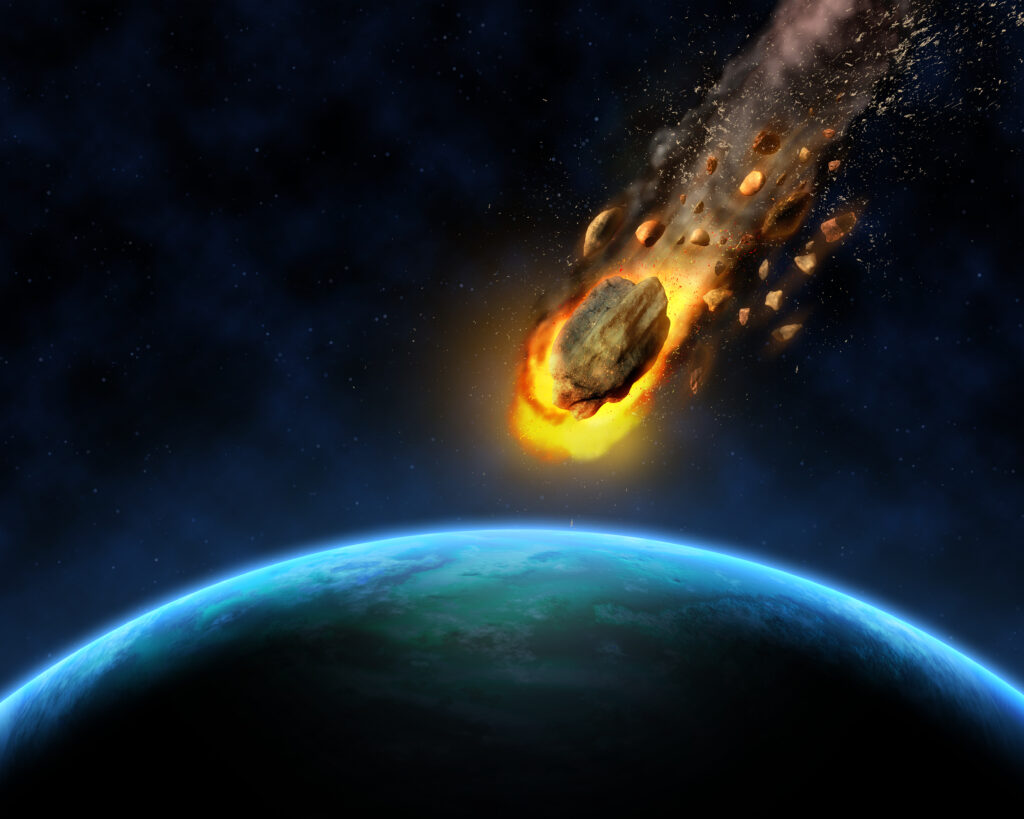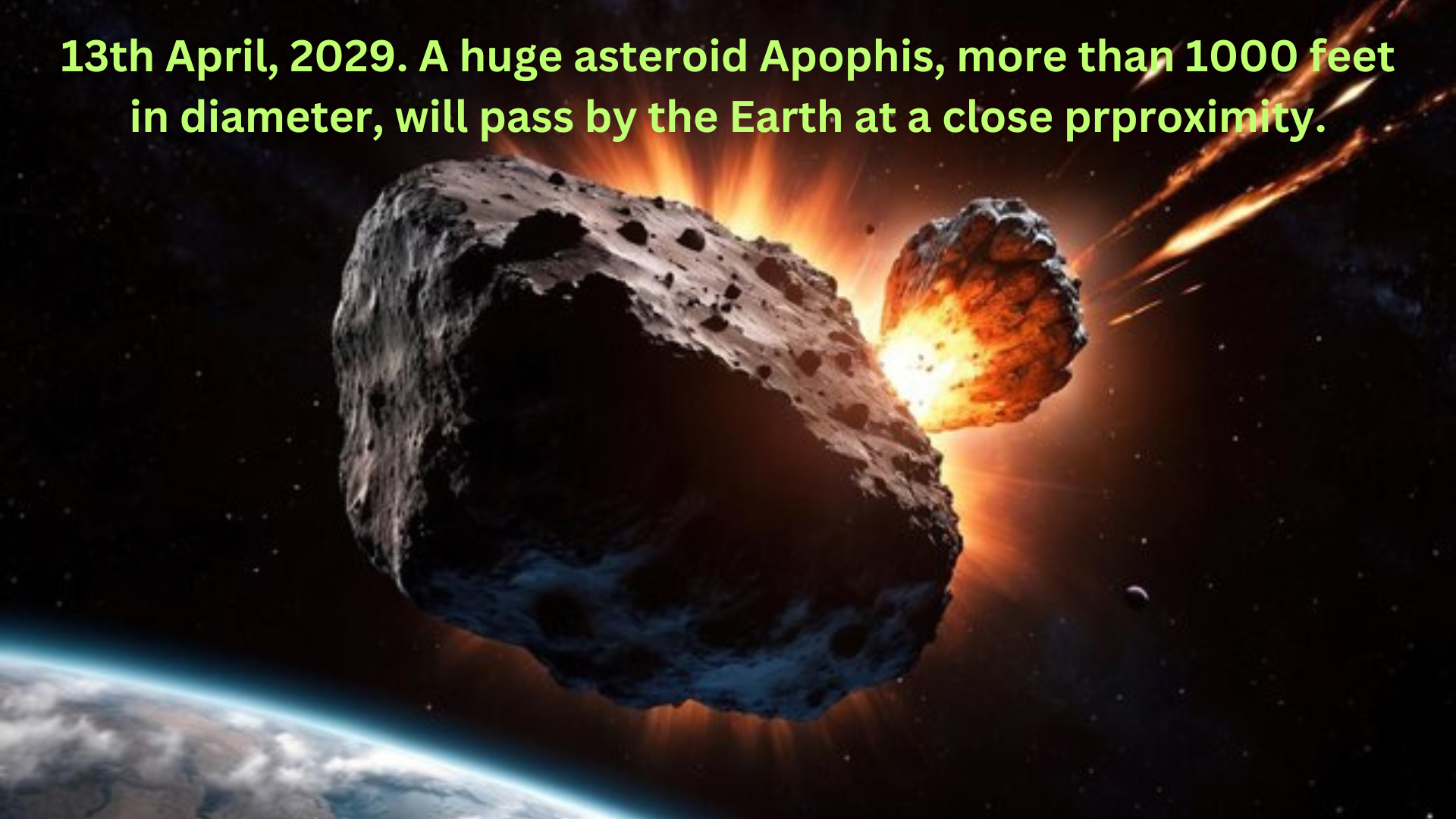Hello friends! 13th April, 2029. A huge asteroid Apophis, more than 1000 feet in diameter, will pass by the Earth at a close prproximity.
If it hits the earth, it will bring about such a devastation which has never been seen before in human history. Compared to the bomb dropped on Hiroshima this will release 1 million times more energy. There will be tsunami waves of hundreds of metres. And entire cities will be wiped out. But not only that, on 12th July, 2038, another asteroid can collide with the earth.
And look at this post. There is a 72% chance of this collision. NASA has already issued an alert and has started its planetary defence exercises 13th April, 2029. A huge asteroid Apophis, more than 1000 feet in diameter, will pass by the Earth at a close prproximity. And look at this post, it’s only a few weeks old. After NASA Chief, ISRO’s Chief has now issued a warning that we can all go extinct. Oh, my God! An earth-destroying asteroid is speeding towards us. ISRO Chief says that migrating to Mars is an option and all global space agencies are working on it. How much truth is there in such news? Which asteroids pose the most danger for Earth?

And what is NASA’s plan? Let’s understand all these things in depth in this video. Asteroids are also called Planetoids. Because they are like small planets. They are basically some huge pieces of rocks that are orbiting in space. Their diametre can be as small as 10-20 metres or as big as 100-200 kilometres. The smallest existing asteroid we’ve discovered is only 2 metres wide and the biggest is called Ceres with a diameter of 940 kilometres. Most of the asteroids in our solar system are found in the Asteroid Belt between Mars and Jupiter.
It houses millions of asteroids. The drawing of this asteroid belt in our textbooks looks like this. This might seem like these asteroids are so close to each other, but in reality, the average distance between any two asteroids is more than 1 million kilometer. But sometimes these asteroids move away from this belt and get quite close to the earth. In such cases, these are known as Near Earth Objects. In short, they are called NEOs. NEOs are not just asteroids, they can be Comets, Meteors, Meteorites, and Meteoroids.
You may ask what is the difference between them? Basically, all of them are just pieces of rocks moving through space. But the way we define them, is different for each. Like asteroids are made of rocks and metals. Comets are made of ice, rocks, and dust. They are known as Dirty Snowballs too. Asteroids are found between Mars and Jupiter in the asteroid belt. Comets are found in the Kuiper belt. This belt lies before Neptune, quite far from our Sun. When comets move in space, they seem to have a tailwhich asteroids don’t. Typically, comets can be large too, with a diametre of 1-10 km. And whenever a comet passes by earth, it can be easily seen with the naked eye. But to see asteroids, telescopes are needed in most cases. In terms of danger posed to us, a comet is far more dangerous than an asteroid. Because first, a comet travels at twice the speed of an asteroid. And second, the warning time is shorter. A comet may suddenly appear and collide with the Earth, and unfortunately, we won’t find out about it for a long time.
And for that we will have only 6-7 years to prepare. The detection systems on Earth, work well most of the time, but sometimes they might not. I would like to tell you about 4 most popular detection projects. The first is LINEAR, Lincoln Near-Earth Asteroid Research. It was started in 1996 by the US Air Force, NASA, and MIT, in a joint collaboration. Two 1-metre long telescopes and a 0.5-metre telescope is used to discover more than 10,000 objects every year. Today, out of all the asteroids that are being discovered, 65% of them are being discovered by this project. The second is CSS, Catalina Sky Survey. Established by the University of Arizona in 1998, it uses two big telescopes. Its measurements are so precise that in 2008 it found an asteroid which was only 4 metres in diameter. And it had accurately predicted the exact time and day when this asteroid will fall on the earth and the exact location. 19 hours after its prediction this asteroid fell in the desert of North Sudan the same place it had predicted.
The third is PAN STARRS Panoramic Survey Telescope and Rapid Response System. It is located in the middle of the Pacific Ocean in Hawaii and it uses the world’s largest digital cameras to find asteroids. The images captured by this largest camera are of 1.4 billion pixels. And the fourth is ATLAS Asteroid Terrestrial Impact Last Alert System.
It is also located in Hawaii. And scientists have created it as a final warning of sorts. In case all the other systems are unable to detect an asteroid, if an asteroid goes undetected by mistake, then this system will give us a last minute warning of a possible asteroid impact. Every night this system scans the sky twice to detect any danger. So overall, Earth’s defence system is quite brilliant and strong. But sometimes there might be some errors. Like, sometimes small meteors remain undetected as they get closer and then collide with the earth. Like the Chelyabinsk meteor in February 2013. This 20-metre wide meteor was not detected by any system on time. That’s why for such scenarios,
a Civil Defence Component becomes crucial. NASA has talked about this on Page 12 of their mock test report. If a small asteroid or meteor is about to crash somewhere International coordination is required at the right time, as well as the activation of the Disaster Management plans. But what will happen if a large asteroid is about to collide? There are three strategies to deal with it. First are the Kinetic methods, second are the Slow Push and Pull methods and the third are the Nuclear methods.
The first of these three, the Kinetic Method is the only one that has been successfully tested in real life. In this, we send a spacecraft that collides with the asteroid and changes its orbit. The asteroid moves in a new orbit. This is a simple and effective method. Its practical experiment was conducted two years ago in NASA’s Double Asteroid Redirection Test (DART). On 26th September, 2022, a 170-metre-wide Dimorphous asteroid was in space, far away from Earth and NASA launched a spacecraft to collide with it.
“NASA’s first planetary defence test to strategically crash into an asteroid…” This asteroid didn’t pose any danger to us. It was just an experiment to see whether doing this really changes the orbit of the asteroid or not. You can watch the video of this collision on the screen. After that, when NASA looked at the result, the asteroid’s orbit had actually changed. The same experiment is going to be conducted by China’s National Space Agency next year. In 2025, they will have their spacecraft collide with a 30-metre-wide asteroid,
And try to change its path. The second method is Slow Push and Pull. In this, we change the asteroid’s orbit gradually. Solar energy can be used for this. If a spacecraft is sent near the asteroid it can concentrate the sun’s rays on the asteroid to vaporise a part of the asteroid, this reaction will release some amount of gas, which will cause a small thrust on the asteroid. And gradually, the asteroid will change its orbit. This happens naturally on asteroids when an asteroid passes near the sun.
But if it is done by sending spacecraft, scientists’ only concerns is before the rocks on the asteroid are vaporised, these rocks should not interfere with the spacecraft’s optical system. Thirdly, we have the Nuclear Method. Literally, sending a spacecraft carrying nuclear bombs to destroy the asteroid. It sounds very filmy but realistically, it may hardly ever be used. There are two reasons behind this. First, deploying a nuclear bomb in space can lead to many legal, international, and geopolitical problems.
And second, when an asteroid is destroyed, its pieces will be blown up all around and we can’t control the orbit of those pieces. A piece may even collied with earth after the asteroid is destroyed. But this method is still under consideration because if an asteroid is large beyond an extent, like if the asteroid’s size is more than 10 km, the same size that caused the extinction of dinosaurs. Then the other methods may not work as well because of the extreme size of the asteroid. In NASA’s mock test from a few months ago
They discussed these points. “Exactly how to deal with an asteroid which is going to collide with the Earth after 14 years with a chance of collision at 72%.” The good news is that 81% of the participants participating in this mock experiment believed that we are ready to deal with such a threat. There are only a few gaps that scientists have raised regarding such scenarios. For example, one gap mentioned was that we have tested only one method till now, the Kinetic Method. We should test this Kinetic Method more times in the future
So that we can be sure that it will work as needed. This was the 5th meeting to discuss a hypothetical asteroid strike. Before this, in 2013, 2014, 2016, and then in 2022, similar meetings were held. It was named Planetary Defense Interagency Tabletop Exercise. And in John Hopkins Applied Physics Laboratory, around 100 experts came together. So, in conclusion, friends, there is nothing to worry about. First of all, in the next 100 years there are no big asteroids that have even a 0.01% chance of colliding with the Earth.
Secondly, our Earth’s defence systems are becoming more advanced with time. In the year 2028, NASA is planning to launch a space telescope named Near Earth Object Surveyor. It will be stationed outside Earth, to detect such asteroids so our detection systems will improve further. And thirdly, even if we find an asteroid that can collide with the earth, we already have adequate systems to stop it. So stop believing in such fake news and if you are interested in space-related topics, I have made many other videos on space.

